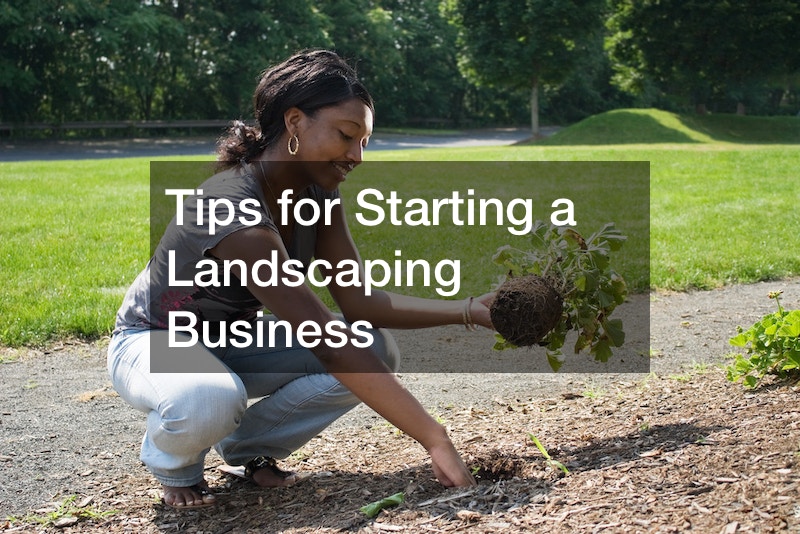

The global landscaping market was valued at $296.09 billion in 2022. And from 2023 to 2030, it’s expected to expand at a compound annual growth rate of 6.4%. The accessibility of high-technology landscaping tools by different types of landscapers and organic gardening popularity has led to significant growth. That said, you can take advantage and join this lucrative field. Here is how you can start the business:
1. Create Your Plan

Before starting your landscaping business, sit down and make a plan. Since you are starting up, it doesn’t have to be a comprehensive plan. But determine how you will carry out the basics. First, consider which area you want to serve and what services you will offer. If it is irrigation installations in a particular area, then you will easily narrow down what skills you need.
Many landscaping businesses hire different types of landscapers to overcome the competition in the modern market. So, if you plan to thrive in this business, focus on general landscaping with different professionals who understand their fields. Once you take the contract and offer hardscaping and softscaping as a package, you will stand a chance of getting more income.
Another thing to consider in your plan is how you will market your business. Determine by checking which marketing method is affordable or popular in your area. If it’s local sign companies, check on their offers and determine which will be your go-to partner.
Various types of landscapers use digital marketing nowadays. For instance, 4.9 billion people are using social media in 2023. This is a better option to get customers if you plan to offer services in different regions.
2. Set Your Startup Capital
The startup capital is the second thing to consider when starting a landscaping business. Many types of landscapers purchase various tools at the start using a short-term business loan, according to OnDeck. You can also secure a personal loan as your startup capital. But if you have some savings, the better for your new business because you will have less pressure servicing the loans.
Here is a list of items you can budget for that will effectively help you to offer professional landscaping service:
- Edger=$109 to $119
- Blower=$109 to $409
- Pickup truck=$30,766
- Mower=$350 to $1,499
- Trimmer=$169 to $249
- Work gloves=$12 to $15
- Safety goggles=$3 to $13
- Steel-toed boots=$76 to $83
- Ear muffs=$89
- Shovels=$13 to $34
- Shears=$13 to $32
- Rakes=$12 to $28
You will need more tools if you have employees. And this may cost you more money at the startup for the purchase and later on maintenance. At this point, you can choose to rent the equipment, as many types of landscapers do. Many landscaping business owners spend 5 to 10 hours a week doing tools maintenance, and this is much time for a growing business.
Generally, you can start the business with around $10,000 if you purchase the equipment. But if you hire various tools, the cost may be lower. However, consider purchasing your tools as the business grows because hiring a wide range of equipment can hike the expenses.
3. Register Your Business

Choose a business name to register with the state. A good business name must reflect the business entity and goals. But also look at the state’s naming guidelines. For instance, if you plan to start your business entity, such as a limited liability company, never use a name that is used by other types of landscapers.
Secondly, you don’t need to choose a name close to your competitors. Confusion could limit your growth when it comes to brand marketing. Finally, choose a web-friendly name, considering everything is marketed online nowadays.
Choose a Limited Liability Company or corporation during business registration because it offers more protection. The sole proprietor with a “Doing Business As” (DBA) name will not offer you liability protection. For example, if injuries or damage to client property happen when offering landscaping services, the insurance can compensate them.
So, we have agreed it’s either corporation or an LLC, and this is how you register. Start by filling out the appropriate paperwork with the state agency. You can obtain the papers from the relevant state agency website.
4. Get a Tax Identification Number
With the paperwork, you receive from the state agency, file for the tax identification number (TIN). TIN is used by the Internal Revenue Service (IRS) in the administration of tax laws. This number is necessary for your business because you will need it when filing tax returns and claiming your treaty benefits.
You can have a particular type of TIN as an LLC or corporation, known as the Employer Identification Number (EIN) or Federal Tax Identification number. It’s always necessary if you have different professionals as your employees. EIN is used for business identification, while TIN is used to identify people who can be taxed.
To register for the TIN, you must gather information like the business name, name of the person responsible for the business, your personal tax identification number as an individual responsible for the landscaping business, business mail address, business entity type, the state it’s registered in, when the business was legally formed, number of employees you expect to hire, etc.
Note that you must be a US-based business to be eligible for the Tax Identification Number. So, after gathering the information, file an online application through the IRS website. Once the information is validated, you will get the TIN in PDF and download it from the website.
5. Open a Business Bank Account

Many landscapers have separate business bank accounts because it comes with several benefits. It will help you to separate business finances from your finances. Secondly, organizing expenses and incomes is easier because you’ll keep records.
Another benefit of a business bank account is professionalism. Once you offer your hardscaper services, for example, your client will see you as more professional by offering bank details for payment. Moreover, a bank account allows you to establish a good relationship with the bank in case you need credit in the future.
When choosing a business bank account, there are several things you must consider. For example, you must look for the fees and requirements of your preferred account in a specific bank. Fees include maintenance, transactions, early termination, and deposit.
The second thing many types of landscapers take advantage of is the introductory offers. Most offers include bonus cash for depositing a certain amount of money and maintaining the balance for a certain period. Other institutions offer lower transaction fees for new businesses. So, you can take advantage of these offers but always pay attention to how the institution will treat you in the future.
Another factor to consider is whether the bank offers online services. A study shows that small businesses have opted for digital transactions to drive growth. As such, it’s necessary to confirm whether their website or the mobile App will work better for you. Also, check if they offer merchant credit card processing because you need merchant services to accept credit card and debit card payments.
Finally, consider if the bank has a branch near you for emergency services. And always remember the fund protection and the insurance. Once you confirm the above facts, proceed with the business registration and the Tax Identification Number certificates to open an account.
6. Get the Required Business Insurance
You must obtain a few forms of business insurance to ensure your employees and business are secure. The most common insurance cover that all types of landscapers must have is general liability insurance. This insurance covers all the repairs due to damages caused by your employees.
Workers’ compensation is another coverage you need for your workers. This insurance covers the medical bill if your workers hurt themselves during tree removal or other landscape activity. In many states, these two insurances are mandatory to operate legitimate businesses.
Another form of insurance that isn’t required but can benefit you are commercial vehicle insurance. Moreover, obtain a pesticide charter if you want to use pesticide applications as part of your services. However, confirm first because the pesticide charter is uncommon in all states. Visit the relevant offices or consult other landscaping business people to learn of all the insurance you need for your business. Most chemical handling activities require insurance and licenses. It’s also no surprise that not every business insurance agency offers all forms of insurance. To ease the process and pay less for coverage, choose the agency that will cover all your business needs.
7. Set Your Rates
If it’s retaining wall paver as one of the services you will offer, consult a professional to know the hourly rates and how much you should charge the client for profit. For this reason, consult several landscapers in your area to learn their rates and determine your rates for each service you offer.
When setting the rates, be careful of inflation so that you don’t make losses. Cover Wallet gives one tip to avoid making losses by offering value to the customers rather than focusing on money. Lastly, when calculating the rates, ensure your charges cover your overhead. Overhead includes costs for fuel and supplies like fertilizers, pesticides, etc.
8. Hire Professionals
Once you are done determining the services, start hiring different types of landscapers based on their experience. Examples are:
- Lawn care specialists
- Mason
- Irrigation technician
- Gardener
- Hardscape supervisor
- Machine Operator
- Landscape architect
- Arborist
To ensure you hire experienced and qualified people, go through the applications and ensure the people you choose are certified. Secondly, call them for in-person interviewing and assessment tests. Remember to ask for references and background checks.
9. Develop a Marketing Plan

When marketing the landscaping business, many landscapers will choose online marketing. Digital marketing has become one of the most effective ways to grow the brand. But only some marketing strategies will work in your area.
Determine which method is effective for reaching out to more people. For instance, you can build a website and hire an SEO company to create content and reach more audiences. With a website, you can add a google my business profile to get discovered in local searches.
Also, create social media accounts like Facebook, Twitter, and Instagram to reach the audience. In fact, social media was the leading marketing channel, according to a recent survey. Further, register with online business directories like yellow pages.
Pay-per-click advertising is also another effective way to reach the audience. With this method, you can place Ads on Google or Bing. And once you offer quality services, the word of mouth marketing starts as customers refer others to your business. Additionally, do direct outreach to local homeowners and businesses.
Another effective way to market your business is attending local networking events and business associations. That said, every marketing strategy works differently for various types of landscapers worldwide.
10. Have Your Business Financials in Order
In the landscaping fields, many types of landscapers keep their finances on track to avoid losses and revise their rates where necessary. And nowadays, you don’t need a pen and paper since we have moved to the digital era. Start with a spreadsheet to keep the records and a folder to store the bank transactions receipts.
When your business grows, consider the App since spreadsheets cannot handle extensive data. Apps and software help with inventory management and employee payrolls. Additionally, it eases accounting jobs when filing tax returns. As such, accounting software is suitable for a new landscape business.
Starting a landscaping business is easier if you plan on your budget and know the necessary tools. The second thing you must consider is obtaining legal documents to operate the business. Finally, know the types of landscapers you must hire for your business to offer all landscaping services as a package for competitive advantage.






